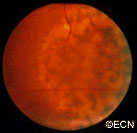By Paul T. Finger, MD
Description
Malignant tumors from other parts of the body can spread into and around the eye. Though they are the most common intraocular cancer in adults, they usually go undetected. This is because most ocular metastases go undetected unless they affect vision, are visible to the patient, or push the eye forward. Eye metastasis are most commonly found in the vascular choroid (choroidal metastasis) within the eye.
Ocular or eye metastasis are usually from a breast cancer (in women) and lung cancer (in men). Other less common sites of origin include the prostate, the kidney, the thyroid, and gastrointestinal tract. Blood cell cancer (lymphoma and leukemia) can also metastasize into the eye and orbit. In 18% of patients, the primary source of the metastasis may be undetectable. In these cases, Dr. Finger may have to biopsy the ocular tumor to obtain tissue for pathology (to determine the primary source).
Symptoms
As stated, most patients with choroidal metastasis have no symptoms. However, if the metastasis is on the eye or eyelids, it may be visible. If the metastasis is located behind the eye (in the orbit), the eyeball may be visibly displaced out or to the side. If the metastasis is within the eye (the most common), metastasis patients can can have symptoms of flashing lights, floating spots or distortion of their vision. In that waiting until patients are symptomatic may be too late to preserve vision, Dr. Finger suggests that all patients with a history of metastatic cancer should have periodic eye examinations.
Diagnosis
In that most patients with ocular metastasis have either a known primary cancer and/or metastatic tumors in other parts of their body; a careful medical history is important. Patients know of prior cancer history and many can remember their tumor stage. History taking can also uncover the signs or symptoms of these other cancers. If an eye cancer specialist suspects ocular metastasis, both eyes and orbits should be examined because ocular metastases can be both bilateral and/or multifocal.
Choroidal metastasis is usually non-pigmented (except metastatic melanomas), and has typical ultrasound and angiographic patterns. Choroidal metastasis is usually poorly circumscribed and can cause retinal detachments. They may have spicules of pigment on their surface. Fluorescein angiography may reveal a typical, “starry sky” of hyper-fluorescent micro-aneurysms. Unlike primary choroidal melanoma, they can grow quickly (weeks) and may require prompt treatment.
The patient with metastasis to the eye should also be examined by a medical oncologist. A complete metastatic survey should be performed to “stage” the patient (to see if there are other tumors within the body). Specifically, radiographic imaging including but not necessarily limited to the brain and lung should be performed due to a high concurrent incidence of intracranial and pulmonary metastases. Dr. Finger will likely suggest a total body PET/CT with fusion.
Treatments

Most patients with ocular metastasis have either a known primary cancer and/or metastatic tumors in other parts of their body. A careful medical history can uncover the signs or symptoms of these other cancers. If an eye cancer specialist suspects ocular metastasis, both eyes and orbits should be examined because ocular metastases are commonly both bilateral and/or multifocal.a
Choroidal metastasis are usually non-pigmented, yellow or white (except metastatic melanomas). Choroidal metastasis is usually poorly circumscribed and can cause retinal detachments. They may have spicules of pigment on their surface. Unlike primary choroidal melanoma, they can grow quickly (weeks) and may require prompt treatment. They typically have typical ultrasound findings of variable reflectivity, angiographic (starry sky microaneurysm) and OCT wavy surface patterns that are helpful to establish the diagnosis.
Treatment depends on the type of metastasis and its primary source. Treatment options often include chemotherapy, immunotherapy and radiation therapy. In general, chemotherapy and immunotherapy take a relatively long time to work, whereas radiation therapy is more rapid. The choice of chemotherapy, immunotherapy or radiation therapy typically depends on the type of tumor and the temporal “timing” risk for loss of vision.
FAQs
Q: If I have been diagnosed with cancer, and have no symptoms should I get my eye checked?
A: It is reasonable to have a yearly-dilated eye examination (with examination of your retina).
Q: If I am on chemotherapy do I need to have radiation too?
A: If chemotherapy is controlling your eye tumor you may not need additional radiation therapy.
Q: If I have a metastatic cancer in one eye, can another occur in my other eye?
A: Yes, you should be monitored every 3 to 4 months.









